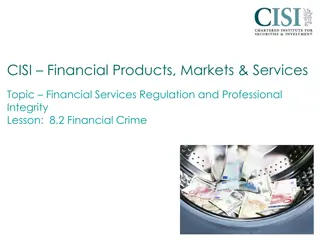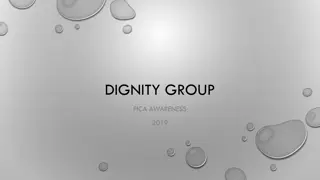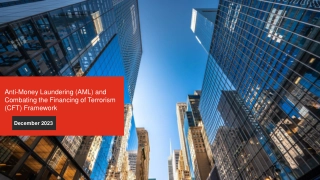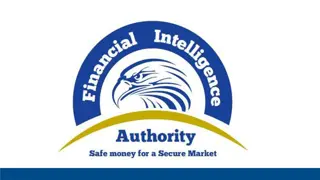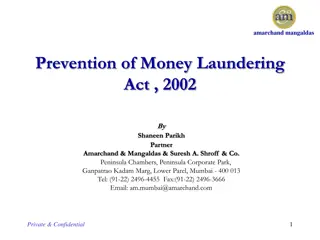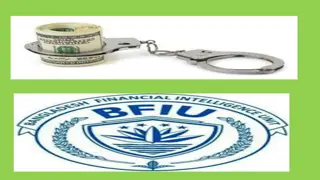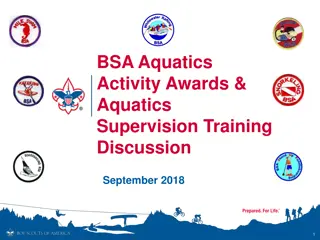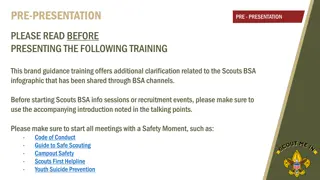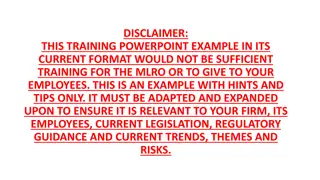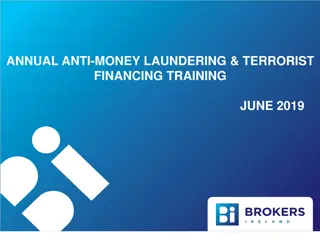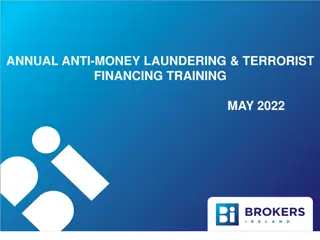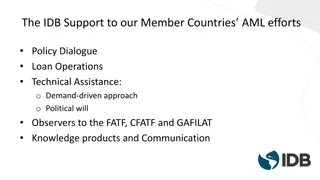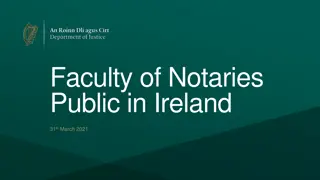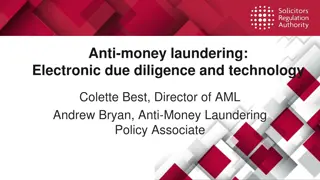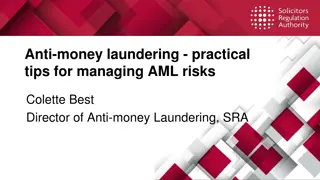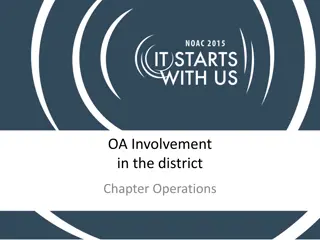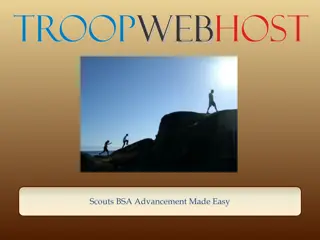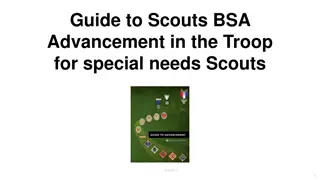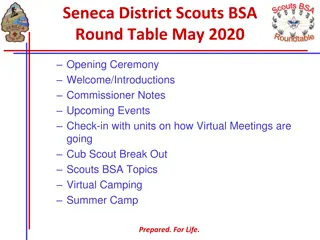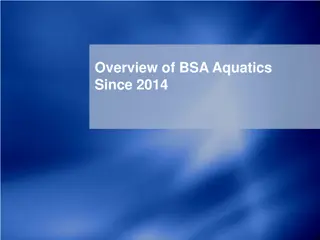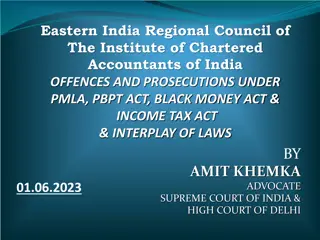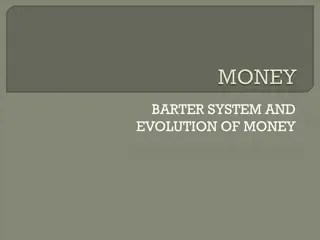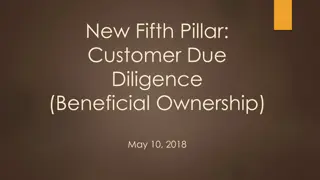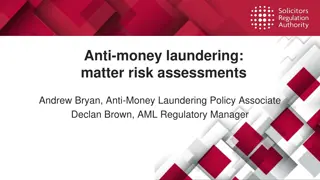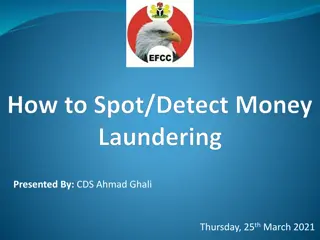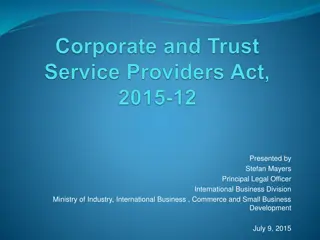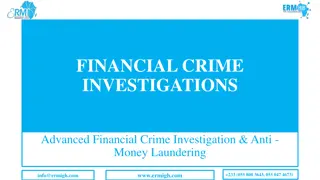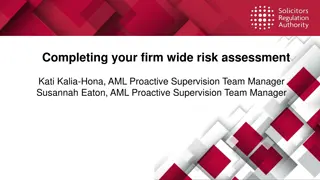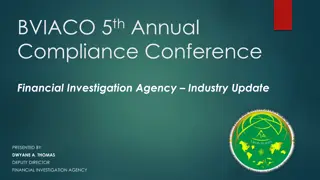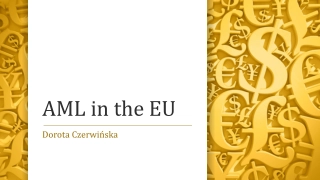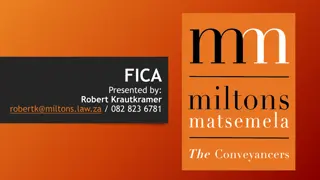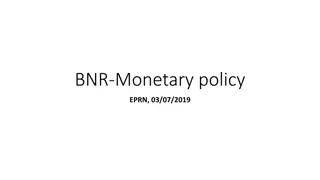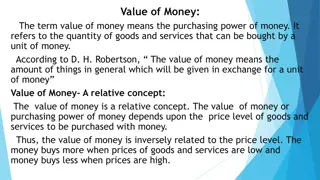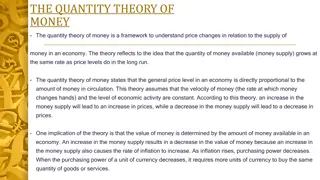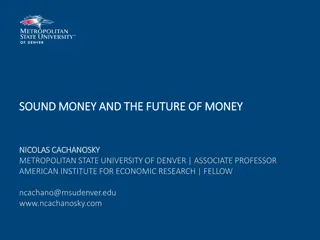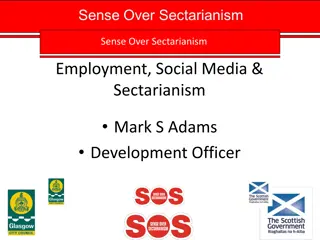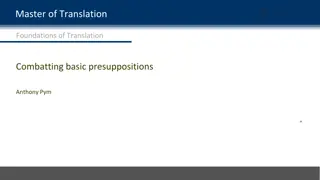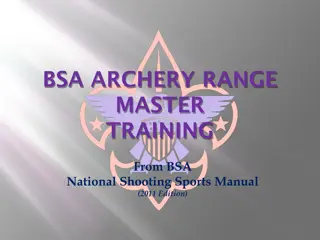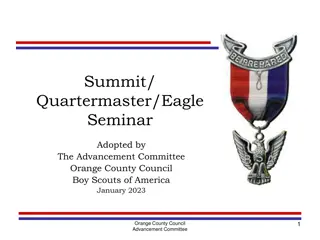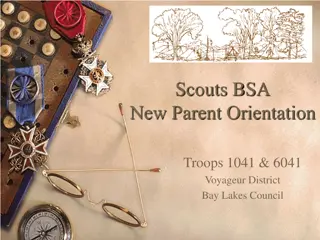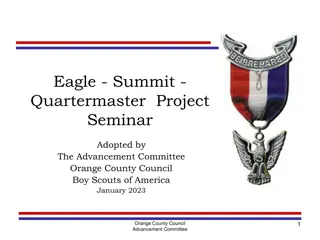Combatting Money Laundering: Understanding the AMLA and BSA
The Anti-Money Laundering Act (AMLA) and Bank Secrecy Act (BSA) play crucial roles in preventing money laundering and illicit activities. The AMLA imposes liabilities on businesses and individuals, with low intent thresholds, while the BSA empowers the Treasury to enforce AML programs. Understanding these acts and their requirements is essential for combating financial crimes effectively.
Download Presentation

Please find below an Image/Link to download the presentation.
The content on the website is provided AS IS for your information and personal use only. It may not be sold, licensed, or shared on other websites without obtaining consent from the author. Download presentation by click this link. If you encounter any issues during the download, it is possible that the publisher has removed the file from their server.
E N D
Presentation Transcript
Anti-Money Laundering Act and Whistleblowers Provision Purpose: Combat use of shell companies for money laundering, terror financing & other illicit activities. Matt Austin, Esq. Of Counsel matt.austin@nelsonmullins.com Charleston, SC (843) 534-4301 Bart Daniel, Esq. Partner bart.daniel@nelsonmullins.com Charleston, SC (843) 534-4123
Anti-Money Laundering Act (AMLA) Enacted January 2, 2021 with overwhelming bi-partisan support Strengthens the Anti-Money Laundering (AML) provisions of the Bank Secrecy Act of 1970 (BSA) President Biden s DOJ and SEC expected to increase focus on AML and White-Collar crimes 2
What is Money Laundering? Various types of financial transactions that are conducted by criminals to conceal the location, ownership, source, nature or control of illicit proceeds. Illicit proceeds are made virtually unrecognizable from proceeds derived from legitimate sources and, thus, are usable within the national and international financial system. Big Picture: Make dirty money legitimate 3
Why does the AMLA matter to your clients? Imposes criminal & civil liability upon businesses and high net worth individuals Low threshold for the Government to prove intent Imposes registration requirements for small businesses 4
Bank Secrecy Act (BSA) Main AML legal authority in the U.S. since it was enacted in 1970 Gives the Secretary of the Treasury authority to implement reporting, recordkeeping and AML programs for financial institutions FinCEN Department of Treasury Bureau delegated authority to administer and enforce the BSA oIncludes the US Financial Intelligence Unit oResponsible for maintaining Suspicious Activity Reports (SARs) 5
BSA Main Requirements AML Programs Currency Transaction Reports (CTR) Cash Reporting or Form 8300 Reporting Suspicious Transaction Reporting Customer Due Diligence Programs (CDD) Customer Identification Program (CIP) Recordkeeping Government Information Sharing 6
Building on the BSA Money Laundering Act (1986) o Created the two primary criminal money laundering statutes in use today (18 USC 1956 and 18 USC 1957) o Expanded definition of financial institution Patriot Act (2001) o Strengthened provisions of the Money Laundering Act of 1986 relating to crimes committed by (1) Foreign Nationals and (2) Foreign Financial Institutions Anti-Money Laundering Act (2020) 7
Financial Institutions Under the BSA Includes traditional banking institutions Also includes non-banking entities: o Insurance companies o Dealers in precious metals, stones or jewels o Pawnbrokers o Loan and finance companies o Travel Agencies o Telegraph companies o Businesses engaged in vehicle sales, including automobile, airplane & boats o Persons involved in real estate closings & settlements o Casinos or gaming establishments with annual gaming revenue > $1,000,000 o Catch-All: any other business designated by the Secretary whose cash transactions have a high degree of usefulness in criminal, tax or regulatory matters 8
3 Stages of Money Laundering (1) Placement - involves the introduction of illicit funds into the financial system (2) Layering - illicitly placed funds undergo a series of processes to conceal their true source and ownership (3) Integration - illicit funds become indistinguishable from legitimately obtained funds and flow undetected through the financial system 9
Anti-Money Laundering Act (AMLA) Why AMLA is needed: More than 2 million limited liability companies are formed each year under U.S. laws Most states don t require any information about their Beneficial Owners FinCEN (Financial Crimes Enforcement Network) previously limited in its ability to track the true beneficiaries of suspicious financial transactions 10
Anti-Money Laundering Act (AMLA) Why the AMLA is needed: Kenneth Blanco, Director of Financial Crimes Enforcement Network (FinCEN): [T]he implementation of the AML Act is the Agency s current number one priority [This is] a landmark piece of legislation that will bolster the United States national security and help better protect the communities and people of this great country. Law360 | March 22, 2021 11
Why AMLA is Needed Prior to the AMLA, financial fraudsters and drug criminals have long used the secrecy & shield of LLCs to hide and launder their ill-gotten gains. More recently, terrorists have hidden behind secret, shell LLCs to plot and finance their terror operations. 12
Why AMLA is Needed Prior to AMLA, prosecutors primarily used 2 criminal statutes: o18 USC 1956 Traditional Money Laundering o18 USC 1957 Engaging in Monetary Transactions in Property Derived from Specified Unlawful Activity; convicted criminals can be charged with money laundering for each purchase greater than $10,000 13
Federal Criminal Statutes 18 USC 1956 Example: oDrug kingpin stashes his dirty drug cash in LLC; purchases real estate, securities, or a legitimate business and puts those in the name of a second LLC. Drug $ Wash Buys Clean Assets 14
Federal Criminal Statutes 18 USC 1956 Penalties: o Maximum 20 years imprisonment o Up to $500,000 fine or twice the value of the monetary instruments or funds involved, whichever is greater. 15
Federal Criminal Statutes 18 USC 1957 Example: o If a bank fraudster is convicted, he can be charged with money laundering for each purchase greater than $10,000. Penalties: o Maximum 10 years imprisonment o Maximum fine of $250,000 or twice the value of the monetary instruments or funds involved, whichever is greater. 16
Headaches & Obstacles for Prosecutors Examples from Department of Justice Days: o Bart o Matt 17
AMLA: BIG PICTURE Requires Disclosure of Beneficial Ownership Creates New Weapons for Law Enforcement o Expands Government s Authority to Subpoena Foreign Banks o Allows Sharing of Suspicious Activity Reports o Creates New Criminal Offenses Increases Whistleblower Rewards & Enhances Protection from Retaliation Creates Exchange with Financial Crimes Enforcement Network (FinCEN) Expands definition of Money Transmitting Business Expands Bank Secrecy Act (BSA) to cover the Trade of Antiquities or Fine Arts 18
Disclosure of Beneficial Ownership Info Beneficial Owner defined: Any individual who owns 25% or more of an ownership interest of a company or exercises substantial control over a company A company may have more than one Beneficial Owner all must be named. 19
Disclosure of Beneficial Ownership Info Information required to be disclosed: oDOB oCurrent residential or business street address oUnique Identifying number from acceptable ID document Exempted Entities: oMore than 20 employees oGross income in prior year more than $5 million AND oPhysical office within USA 20
Disclosure of Beneficial Ownership Info Beneficial Owner info filed with FinCEN not publicly available National Defense Authorization Act (NDAA) permits FinCEN to disclose Beneficial Owner info: o To Federal Law Enforcement Agencies; o To Federal Agency requesting info on behalf of a non-U.S. Law Enforcement Agency; o To a financial institution (with the consent of the reporting company) in order to meet customer due diligence requests; and o To state, local & tribal law enforcement agencies if presented with Court Order. 21
Disclosure of Beneficial Ownership Info Any newly formed entity must disclose Beneficial Ownership information immediately. Existing entities must disclose Beneficial Ownership within two years. CONCLUSION: The definition of Beneficial Owner is narrowly tailored to target shell companies, holding companies, or LLCs with limited operations. 22
New Weapons for Law Enforcement Part 1 Expands Government s Authority to Subpoena Foreign Banks o PAST: Could subpoena records relating only to foreign bank s corresponding U.S. Bank Or use an MLAT (Mutual Legal Assistance Treaty) o NOW: Can subpoena records relating to any account at the foreign bank that is subject of a: Money Laundering Investigation Civil Forfeiture Action or Federal Criminal Investigation 23
New Weapons for Law Enforcement Pt. 1 (contd) NEXUS: Foreign banks need only have a branch in U.S., or relationship with a corresponding bank in U.S. o Officers, Directors & Employees of a foreign bank are prohibited from notifying an account holder or person named in the subpoena o Potential civil penalties: Double the amount of the suspected criminal proceeds sent through the correspondent account of the foreign bank in the related investigation or No more than $250,000 if no proceeds identified o A foreign bank that fails to comply with subpoena may be subject to civil penalty of up to $50 thousand per day 24
New Weapons for Law Enforcement Part 2 Allows financial institutions to share Suspicious Activity Reports (SARs) & information with foreign law enforcement to combat criminal activity. o Banks will receive guidance from FinCEN within 1 year on how to share SARs with foreign institutions o FinCEN guidance may also include: Raising the monetary thresholds on which financial institutions must keep certain types of records and Lowering risk factors on certain types of transactions including charities & embassy accounts 25
New Weapons for Law Enforcement Part 3 New Criminal Offenses Created under 31 USC 5335 31 USC 5335(b) Prohibition 31 USC 5335(c) Source of Funds Both carry the same penalties: Maximum term of imprisonment of 10 years; Maximum fine of $1,000,000; OR BOTH 31 USC 5335(e) includes Criminal and Civil Forfeiture provisions 26
31 USC 5335(b) - Prohibition oKnowingly conceal or misrepresent to a financial institution a material fact concerning ownership or control of assets involved in a monetary transaction if: the person or entity who owns or controls the assets is a senior foreign political figure, or any immediate family member or close associate of a senior foreign political figure AND Aggregate value of the assets involved in 1 or more monetary transactions is not less than $1million 27
31 USC 31 USC 5335(c) 5335(c) Source of Funds Source of Funds oKnowingly conceal or misrepresent to/from a financial institution a material fact concerning the source of funds in a monetary transaction that: Involves an entity found to be a primary money laundering concern and Violates a prohibition on opening or maintaining a correspondent or payable through account 28
Expansion of Whistleblower Program Increased the maximum award from $150,000 to 30% of the amount collected if that amount is greater than $1 million Awards to whistleblowers remain in the discretion of Treasury Department Provides protection for Whistleblower from retaliation Whistleblower may file a complaint with Department of Labor If Whistleblower prevails, employer may be required to: Reinstate the employee Pay compensatory damages; and Pay double the back pay & interest 29
Industry Input Financial Industry can help shape the Rules, Regulations & Guidance which FinCEN must promulgate FinCEN Director Kenneth Blanco invited the Financial Industry to comment on the upcoming Advance Notice of Proposed Rulemaking (ANPRM), stating: o This is where your voice, your experiences and your thoughts truly matter. o We review and consider every comment we receive to ensure our rules are effective and clear. No timeline for the ANPRM has been set, but expect it to be within the next 2-3 months 30
Real World Example Bart: Traditional Money Laundering Matt: Trade-Based Money Laundering 31
Trade-Based Money Laundering / Black Market Peso Exchange Mexico Wow, great exchange rate! United States CJNG Cell Release the Dirty Dollars! New Jalisco Generation Cartel (CJNG) Drug Purchasers Peso Broker We want b-balls! We sell b- balls! US Business w/ BOA Account MX Business 32


